Visiting the Alhambra, Granada: 7 top tips
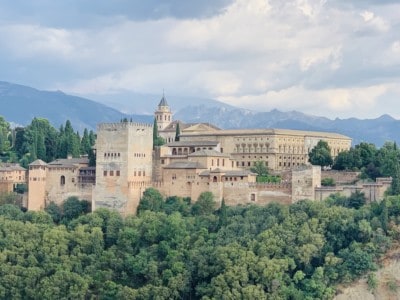
By Emma Marshall
This post contains affiliate links
Visiting the Alhambra is undoubtedly on many people’s bucket lists. It certainly was on mine. But if you’re going on a short break toGranada or Andalucia – and want to make the most of your visit to the Alhambra – there are a few things you should consider.
Read on for my top tips for visiting the Alhambra.
What is the Alhambra?
You may well have heard of the Alhambra, but what is it? Is it a palace? Is it a castle? Or is it a stately home with gardens? Well, although its name is derived from the Arabic for “Red Castle”, the Alhambra is all of these things.
It’s also a place that reflects its construction over many centuries and where you can see the influence of different religions, cultures and rulers. As a result, there are several different sections in the Alhambra, and it’s been designated a UNESCO World Heritage site.
The Alcazaba
The oldest part of the Alhambra is the Alcazaba at one end of the complex. Built by the Nasrid dynasty in the 13th century during Spain’s Moorish era, it is a fort to protect the inhabitants from Christian soldiers.
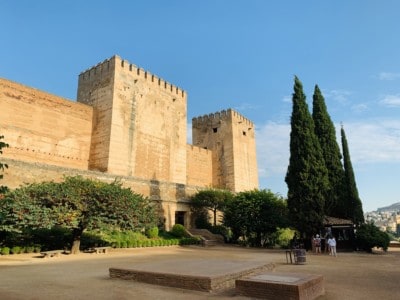
It has a tower (the Torre de la Vela) that you can climb and look out onto the city from.
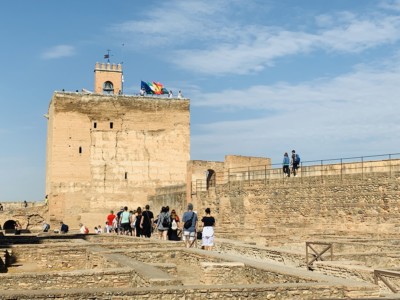
The Generalife
At another end of the Alhambra, you find the 14th century Generalife. This translates as “garden of the architect”. As you may expect from this, it is here that you will find the gardens of the Alhambra, as well as a palace. The entire area was built to serve as the summer residence for the kings.
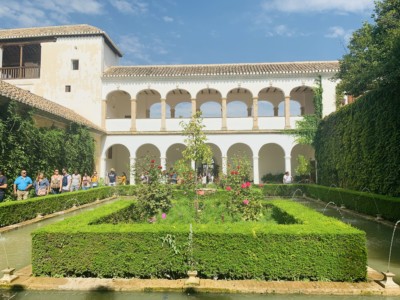
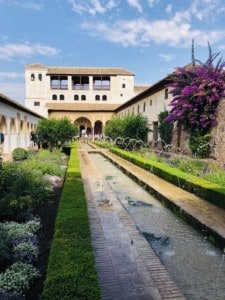
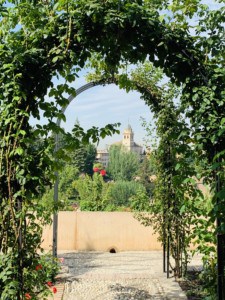
The Palacio de Nazaries
Later in the 14th century, the Palacio de Nazaries (Nasrid Palace) was constructed. This comprises a series of sections – both indoor and outdoor – that were built at different times during the century.
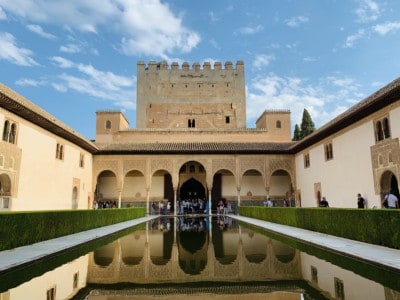
It is where you’ll find the most brilliantly ornate rooms and courtyards, decorated with Moorish designs and inscriptions. There is also a bathhouse and an attractive raised terrace from which you get spectacular views.
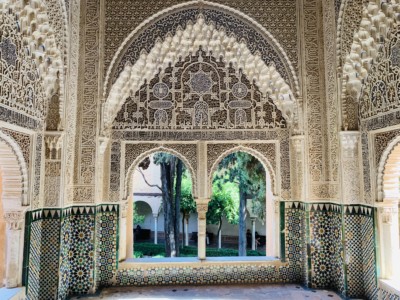
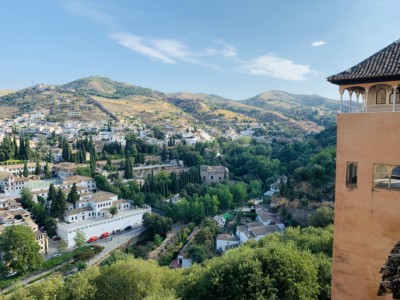
For me, the Nasrid Palace was the standout attraction. This is described in my Lonely Planet guide as “still considered the highpoint of Islamic culture in Europe”. Visit and you’ll discover why.
The Palacio de Carlos V
A further section of the Alhambra reflects the Christian era from the 16th century. Here, you’ll find the Palacio de Carlos V (Palace of Charles V), a renaissance style building with a fine arts museum and the Museum of the Alhambra. Not surprisingly, this has a very different look and feel to it than the Moorish architecture.
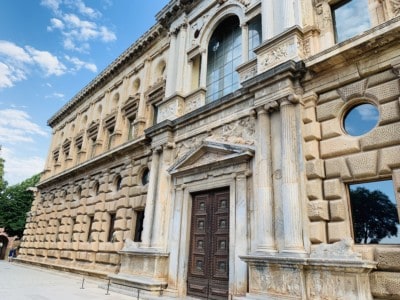
This is a really simplified overview of the different parts and the complex and stages of construction. You really need to visit the Alhambra to fully appreciate just how significant a place this is.
It also explains the Alhambra’s massive scale. As well as a fort, palace, gardens, and numerous towers, there are four museums. There are also two hotels in its grounds, one on the site of a convent. In total, it covers an area of 35 acres and is just under 2,500 feet in length.
Where is the Alhambra?
The Alhambra is set high on a hill in Granada, a city in the Andalucia region of Southern Spain. It is a short walk from the centre of the city.
Granada is around 125 km from Malaga, and 200 km from Cordoba. It is around 250 km from both Seville and Gibraltar. It has its own airport – Granada Federico García Lorca airport – that you can fly to directly. However, depending on your city of departure, flights may not be daily. Alternatively, you could fly to either Malaga or Seville.
The airport is around 20 km from the city centre. Airport buses run from outside arrivals, take 30-45 minutes and cost three euros per person. Taxis are quicker, but cost around 30 euros.
Top tips for visiting the Alhambra
If you’ve set your heart on visiting the Alhambra, then you won’t want to be disappointed. Read on for information on how best to maximise your trip.
Consider when to visit the Alhambra
Visiting the Alhambra is extremely popular with tourists. Indeed, it is Spain’s most visited attraction.
On peak days, thousands of people make their way here (reports vary from over 6,000 to over 8,000). Whatever the exact figure, this means that you’re visiting at the same time as scores of other visitors.
This is not necessarily a problem. The Alhambra is huge so the different tourist groups are usually walking around different parts at any one time.
But it is noticeable that it gets busier as the day goes on. So if you want to visit at a slightly quieter time, I’d suggest going as early as possible in the day (the complex opens at 8.30am). It is also open in the early evening and I have read that visiting the Alhambra at dusk is lovely.
Equally, you might want to think about the time of year that you go. If you’re combining a trip to the Alhambra with a visit to Granada or Andalucía more generally, you may opt for the summer months.
If this is the case, you’ll be able to explore the nearby beaches (around an hour away). You can also sit outside at one of the city’s countless tapas bars or go hiking in the Sierra Nevada mountains.
For information on tours that you could do to the mountains, click here.
For a tapas and walking tour, click here or here.
You could also day trip to Seville from Granada on this tour, to Cordoba here or Ronda here.
If you’re not wedded to a summer trip, we were told by our guide that visiting the Alhambra in either March or November were the best months. His opinion was that a trip at these times of the year combined acceptable weather with months when tourist numbers were lower.
Book Alhambra tickets early
When I say book Alhambra tickets early, I mean early. I thought I was being relatively organised by booking three weeks in advance.
But when I logged on to book tickets there were very few left – and none at the times I wanted to visit. As I write this, tickets for the next two months are sold out and for the following two months only a few tickets are left. So my advice would be to book your ticket at the same time that you book your flight.
How to book tickets for visiting the Alhambra
You can book Alhambra tickets here.
They cost 14.85 euros each and must be made using either Visa or Mastercard. Children can visit for free, but still need to have a ticket. For six euros, you can also hire a handheld audioguide.
Advance tickets can be printed at home, at ticket machines on site or at the ticket office. If printing at home, there are a number of things you need to adhere to ensure you are presenting a ticket of acceptable quality. See the main website for more details.
Tickets cover the three main sections: The Nasrid Palace, the Alcazaba and the Alhambra gardens (Generalife). You can also buy tickets to visit the Nasrid Palace at night, the Generalife at night, and the Alcazaba and Generalife.
If you’re booking a ticket that includes the Nasrid Palace, you’ll be required to book a specific time slot for entering the palace. This was my favourite part of the Alhambra, so if it’s your first time here I’d urge you not to omit this.
You can also enter some sections of the Alhambra for free; however, this means you’ll miss some parts that personally I think are the main highlights (see below for more details).
Consider booking a tour for your visit to the Alhambra
You may also want to consider booking a tour when visiting the Alhambra. I have to admit that we didn’t plan to do this – I am generally a fan of visiting places independently. However, we ended up doing this because we left booking a standard online ticket too late.
Our tour ticket was more expensive than the 14.85 euro online ticket. But I knew that I wanted to visit early in the day so this was the only way we could do this. However, it was so worth the extra money.
Benefits of booking a tour to visit the Alhambra
For our ticket price, we were taken around the Alhambra in a small group and had an English-speaking guide accompanying us. We were also given an ear piece to wear. This allowed us to wander off slightly and explore at our own pace, but still to be able to hear the guide.
For me, the benefit of booking this tour was the information we were given as we walked around. Our guide basically knew the history of the Alhambra inside out.
I’m sure you get a lot of details with the audio-guide that you can hire with the general ticket. However, having a guide meant we were able to ask questions and clarify anything that was unclear.
He pointed out the finer details of the Moorish and Christian architecture and design we saw.
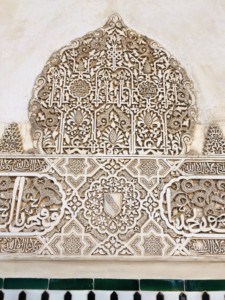
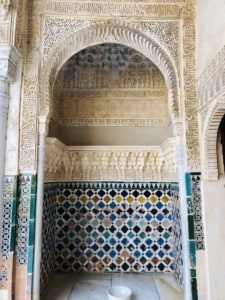
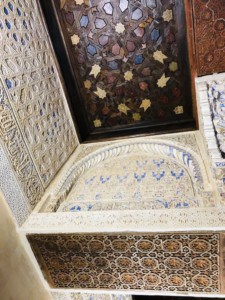
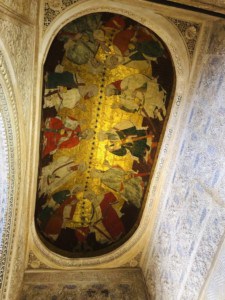
He also drew our attention to small details that we would definitely have overlooked if we were on our own. And he peppered all that he was saying with interesting stories that really brought things to life.
By the time I left, I knew the difference between Moorish and Christian fountains (the former being calm and tranquil and the latter being grander and noisier). I’d been shown the repeated Arabic writing on the walls in the Nasrid Palace, something I would not have spotted without him.
We also heard about a closed door in a section of the Nasrid Palace (you’ll find this after you go through the Mexuar towards the start of your tour around the Nasrid Palaces).
The closed door was apparently designed to delude intruders into thinking this was where treasures were held. They were in fact placed behind the adjacent open door – the last place it was assumed anyone would look.
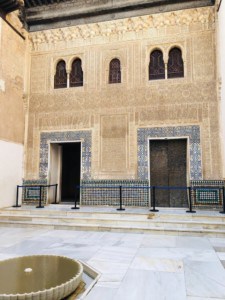
Ideas for tours for visiting the Alhambra
Our tour was booked through GetYourGuide, but there are also other tours available if you search the internet. When you walk around Granada’s city centre, you also find shops offering tours.
If you’re interested in booking a GetYourGuide tour, a selection is below:
Make sure you have enough film/battery for your camera when visiting the Alhambra
Visiting the Alhambra a photographer’s dream. And even if you’re not an avid photographer, you can’t fail to leave without snapping a ridiculous amount of pictures.
The entire site is stunning and packed full of surprises. There aren’t enough superlatives to do the Alhambra justice and you’ll never run out of things to take pictures of.
The key areas for this are below.
The Grand Palacio de Carlos V
There’s the Grand Palacio de Carlos V. This is a renaissance style building with a fine arts museum and the Museum of the Alhambra.
It’s a unique building – a circle within a square as our guide put it. This is because whereas from the outside the building appears to be square, when you walk inside you find a large circular amphitheatre.
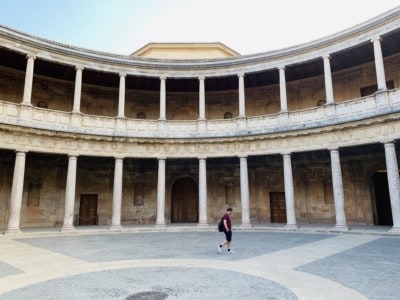
The Alcazaba
There’s the old fort of the Alcazaba, the oldest part of the Alhambra.
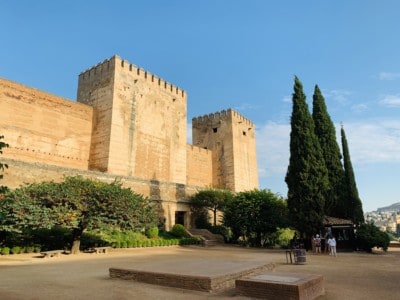
Here we saw the layout of military living quarters and small, sunken holes in the ground. These were used to house prisoners.
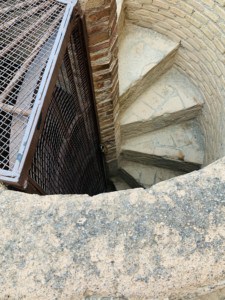
The Alcazaba also has the Torre de la Vela that you can climb up. From here, you get sweeping views back over the hills of Granada.
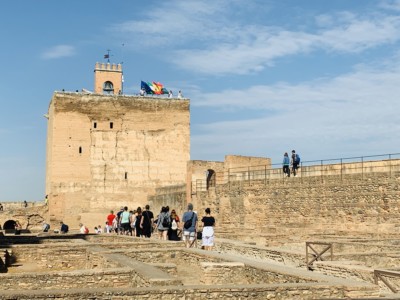
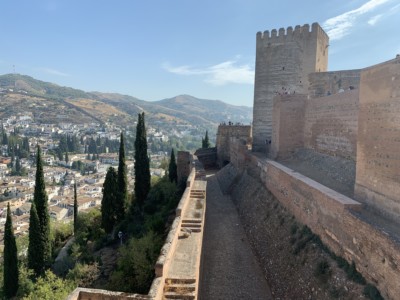
The Alhambra gardens
There’s also the colourful and attractive gardens in the Generalife with yet another palace. These are a short walk from the main complex and served as a summer residence for the Nasrid kings.
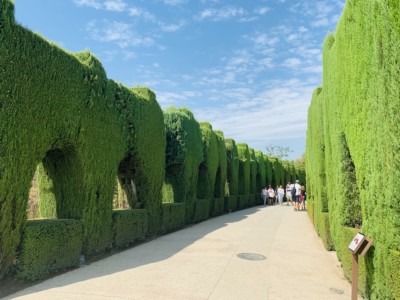
Here you’ll find neat hedges, trees and flower beds, more ornate fountains and stunning views back to the Alhambra palace.
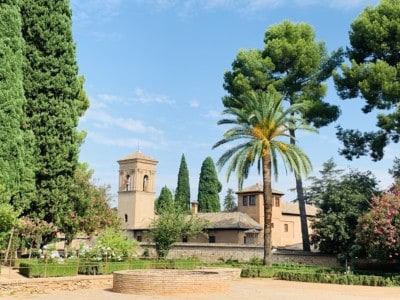
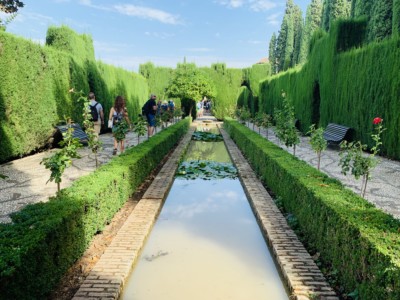
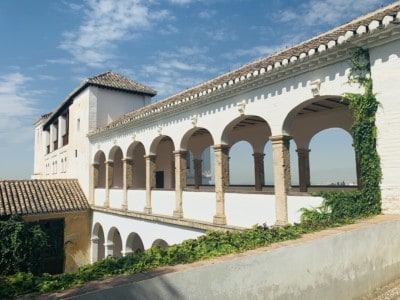
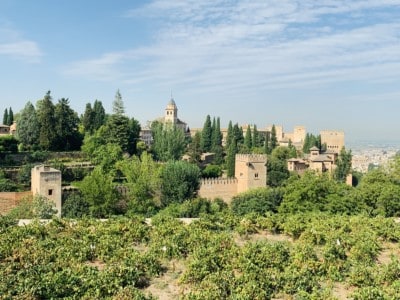
Other parts of the Alhambra also have some outdoor leafy areas.
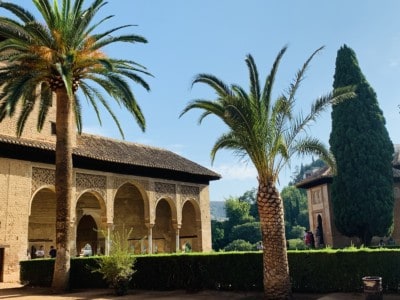
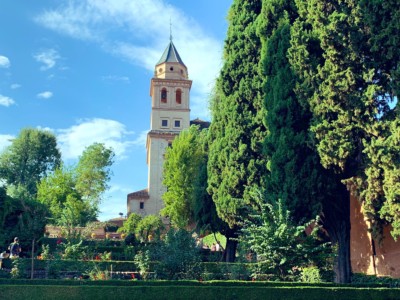
The Palacio de Nazaries
And then there’s everything in the Nasrid Palace. And I mean everything. If you are like me, you’ll end up taking more pictures here than in the rest of the complex combined.
As you can see from the pictures below (and it goes without saying that my pictures do not really do it justice) the different areas are truly wonderful.
The Patio de los Leones
Among the highlights are the Patio de los Leones (Court of the Lions). This is a wonderful open plaza, with a fountain with 12 lions surrounding it in the middle.
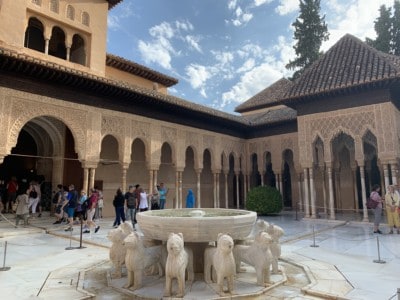
The area is flanked by ornate archways and pillars and there are small pretty alcoves set into the sides.
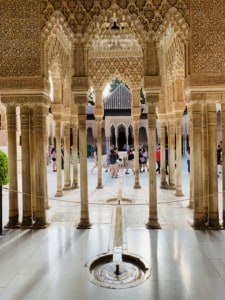
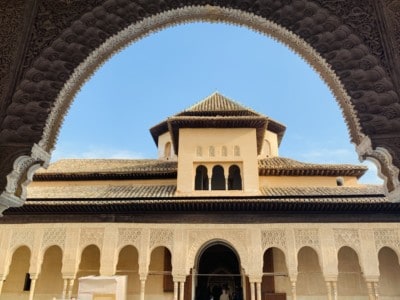
The Patio de los Arrayanes
I had two favourite places in the Alhambra Palace. Both of these were in the Nasrid Palace. The first was the Patio de los Arrayanes (the Court of the Myrtles). This is an outdoor area which is apparently so-named because of the myrtle trees that surround it.
It has a long narrow stretch of water which is topped at both ends with a small fountain. One end then leads to the Palacio de Comares (Comares Palace), the official King’s Palace. In my opinion, it is one of the most stunning areas of the entire Alhambra.
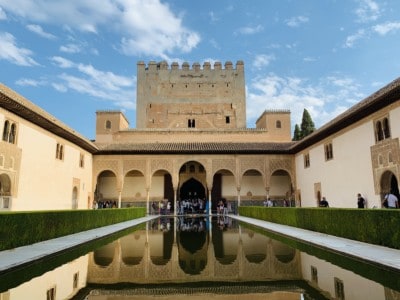
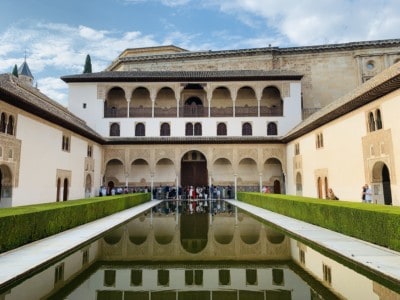
The Salon de los Embajadores
The second place that I absolutely adored was the Salon de los Embajadores (Hall of the Ambassadors). This is inside the Comares Palace. It is a room that literally takes your breath away (this may sound like a cliché but it’s true).
It’s here where I found myself just staring at the walls, ceilings and windows. Just looking at the dazzling patterns and designs is mesmerising.
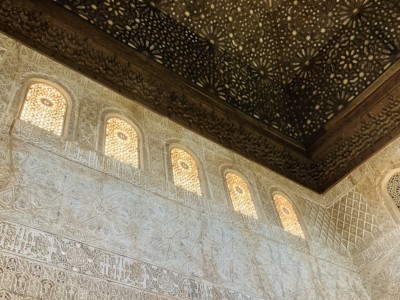
There are also intricate and ornate alcoves set into the wall.
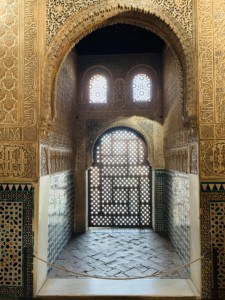
In addition, at the far end is the Sultan’s throne (a remarkably simple affair considering the palace’s occupants). This was apparently positioned here so that the vantage point – opposite the entrance of the room – allowed the Sultan to see who was approaching.
So to reiterate, make sure you have enough film or battery to see you through your visit. Note, however, that the rules accompanying your Alhambra tickets include that it is forbidden to use camera flashes, selfie sticks or tripods in the Nasrid Palace.
Don’t forget to take identification when visiting the Alhambra
We were asked to submit our passport details a few days before our visit to the Alhambra. We still, however, needed to take identification with us.
This is because once inside the complex, there are least four places where you need to scan your ticket and have your identification ready for inspection. This includes the Nasrid Palace, the Generalife Gardens and the Alcazaba.
Without this, if you need it, the likelihood is that you would be refused entry to these parts.
Wear comfortable shoes when visiting the Alhambra
When you visit the Alhambra, you’ll be doing plenty of walking. And I mean a lot! The entire complex covers 35 acres. And whilst you probably won’t be seeing all of it, you’ll be on your feet for hours.
We were with our guide for three and a half hours and only had a 10-minute break. Most of the walking was on the flat, but there were some points where climbing stairs was required.
The Generalife gardens are also a short walk away from the main palace and fort. So wear your comfortable shoes!
Finish your visit with a trip to the best Alhambra viewpoint in the city
After spending most of the day in the Alhambra, you mustn’t miss the opportunity to view this amazing place in its entirety. There are a few places in the city where you can look up and see it. These are generally in the Albaicin district of Granada, the Muslim quarter.
The Carrera del Darro and Paseo de Los Tristes
One place is from the market and cafes lining the end of the Carrera del Darro at the Paseo de Los Tristes.
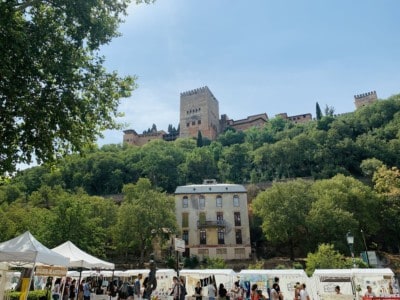
The Carrera del Darro street is in itself worth seeing. It’s a pretty cobbled street that runs along the side of the Darro river and where you’ll find the Archaeological Museum of Granada. You can walk onto this from Plaza Neuva.
The Mirador de San Nicolas
However, the best place is the Mirador de San Nicolas. This is a viewpoint in front of St. Nicholas’ Church at the top of the hill in Albaicin.
You can either walk uphill via the steps from the Carrera del Darro or take a cab or bus (buses run from the Plaza Nuevo). The Granada City Train – a hop on/hop off train – also stops here. You can book tickets for this here.
When you get to the top, you’ll find a small square in front of a whitewashed church. This is a buzzing spot, with a few artisan stalls and buskers providing musical entertainment.
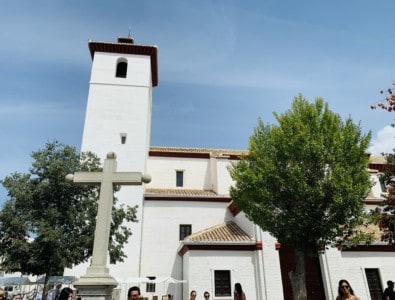
However, I guarantee that as delightful and atmospheric as this square is, the first thing you’ll notice is the Alhambra. Again, as clichéd as it sounds, breathtaking is the only word to describe the panoramic view.
From this vantage point, you get the most picturesque and uninterrupted views of the Alhambra sitting majestically on the opposite hill across the valley. It’s from here that you really appreciate just how vast the entire complex is and what a feat it was to construct it.
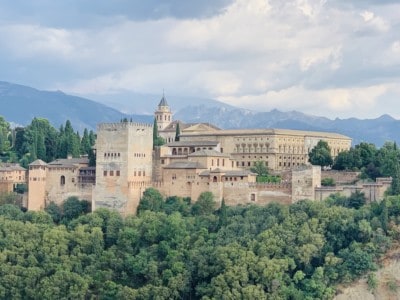
It’s so big that a close up shot using an I-phone can only really capture around a third of the entire complex. Pictures of wider sections of the Alhambra are necessarily quite small….
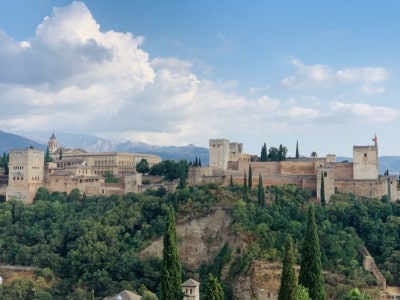
This was yet another highlight of my visit to the Alhambra. And another place where I just wanted to sit and soak in the view for hours.
We came here three times. Our first visit was at dusk as the sun was going down, and when a romantic glow seems to settle over the Alhambra.
The second was the same evening after dinner in a nearby restaurant. At this time, we got to see it beautifully lit up in the dark.
We then came back on our last morning as I just couldn’t resist one final look….
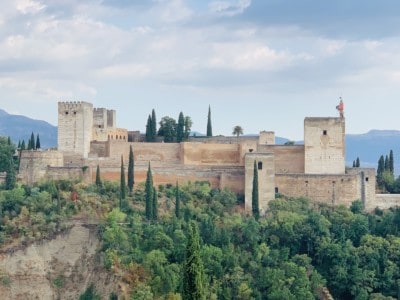
I hope I have managed to convince you what a special place the Alhambra is and one that you won’t regret making the effort to visit. And I hope that my top tips help you plan your trip. If you have any questions – or feel I should add anything to these tips – please let me know.
If you like visiting historical or cultural sites and museums, you might also be interested in some of my other posts:
Nearby to Granada is Gibraltar. If you’re interested in a short trip here, see my 5 must-do things



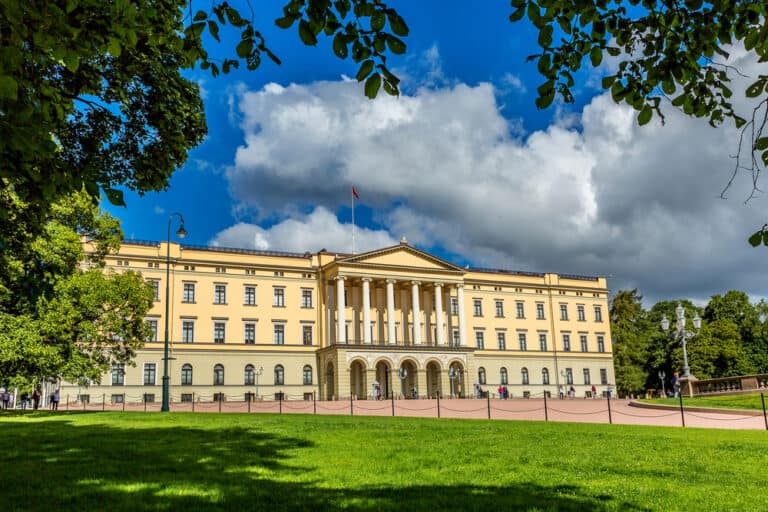
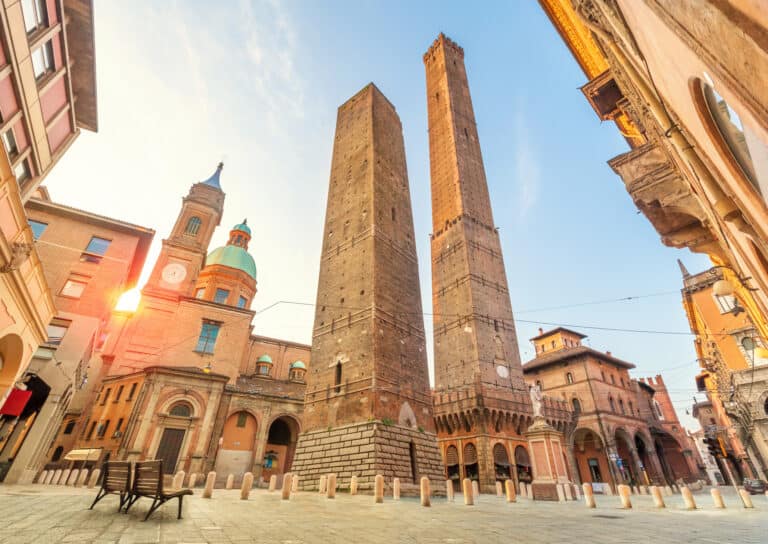
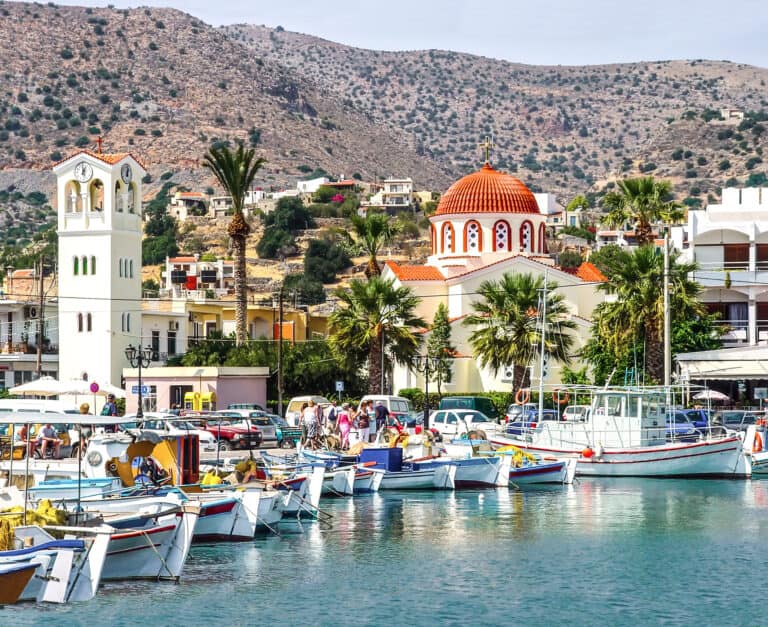
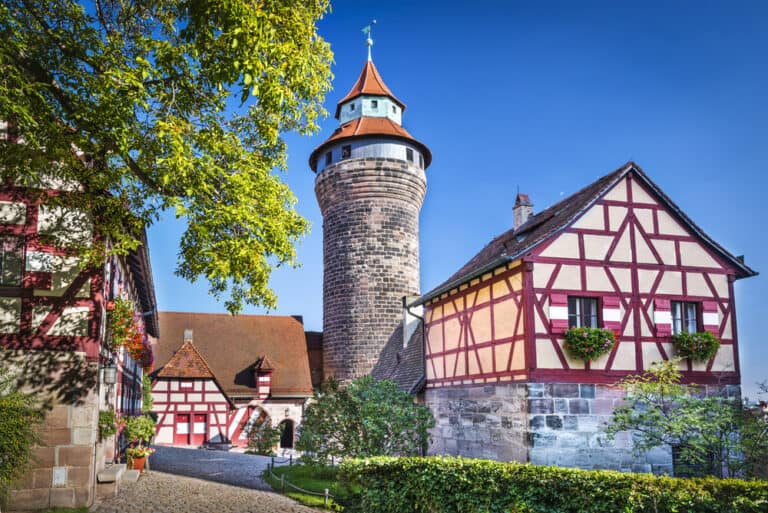
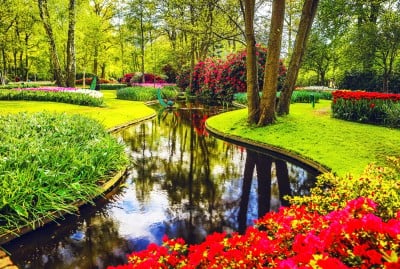
Wow. You’ve made it sound incredibly special, and provided loads of helpful tips. I’m with you on the visiting independently, but sometimes a guide can make all the difference and it sounds like the Alhambra is one of those times!
Thanks Karen. I’d definitely recommend a visit here. It’s very special x